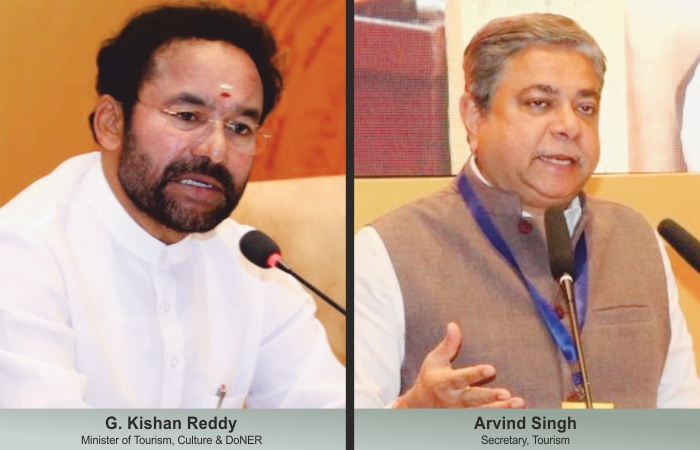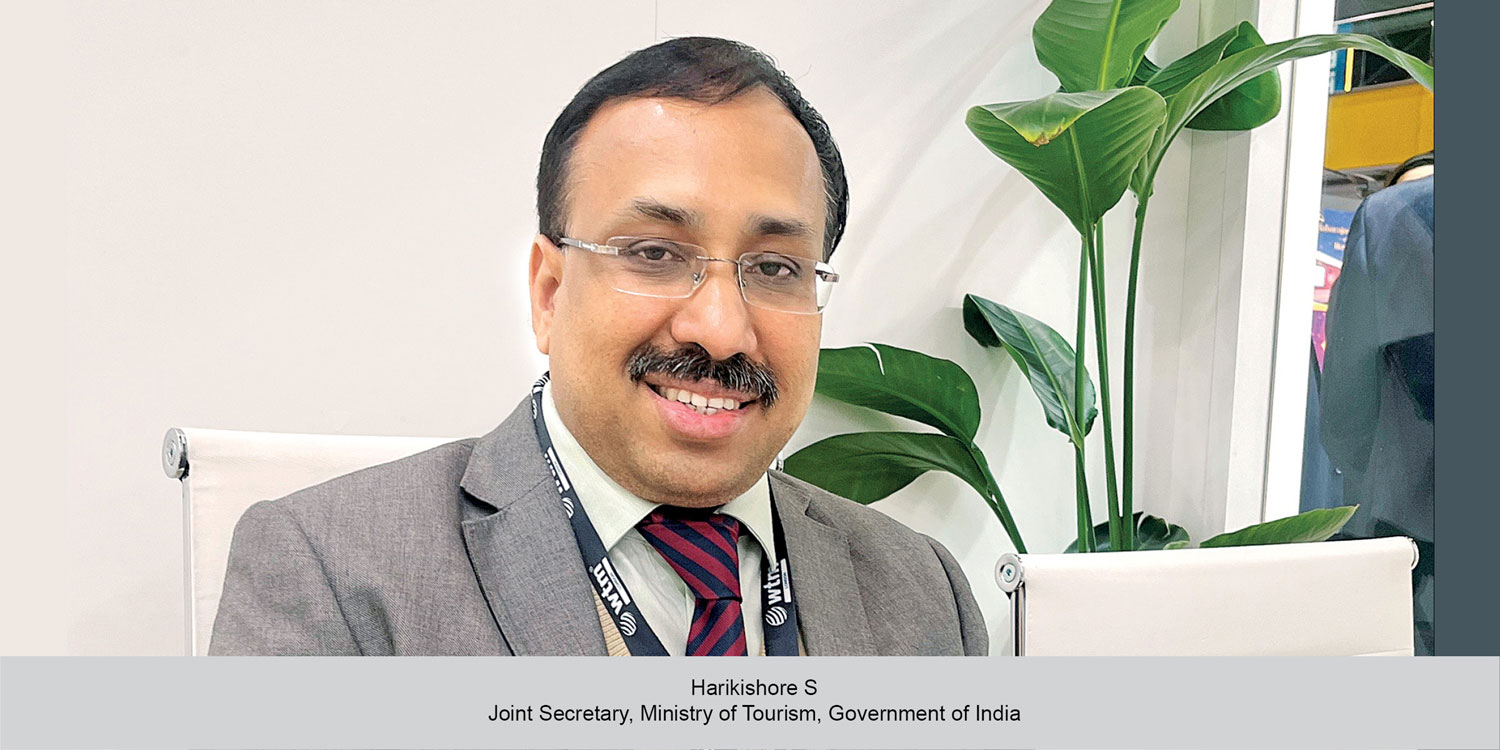The Union Ministry of Tourism’s recent Chintan Shivir in New Delhi, attended by industry associations and leaders, aims to deliberate, ideate and devise strategies for promoting Tourism in Mission Mode in the country.
TT Bureau
The two-day Chintan Shivir, attended by the states, industry associations and industry leaders, had 11 knowledge sessions covering a wide variety of topics. Addressing the gathering on Day 1, G. Kishan Reddy, Minister of Tourism, Culture & DoNER, said that the government’s vision is to leverage tourism as a vehicle for socio-economic development, job creation and achieving sustainable development goals for the country.
He said that it is the most opportune moment to unveil a shared vision for future of India’s tourism, guiding its course for next 25 years to make India as the most sought-after travel destination in the world when India celebrates 100 years of Independence in 2047. He pointed out the three key pillars of developing tourism in mission mode – active participation of the states, convergence of government programs and public private partnerships (PPPs). He said that one major step would be to develop national strategies and models for providing guidance to the states in developing their tourism potential. The Ministry has recently formulated national strategies for development of various tourism sectors such as rural tourism, adventure tourism, M!CE tourism, ecotourism, and medical tourism.
Green tourism is key
Arvind Singh, Secretary, Tourism, called Chintan Shivir a platform for all stakeholders to conduct fruitful interactions and share good practices followed across the country and a stage to share unique ideas involving technological solutions in travel sector, sustainability in tourism and responsible travel with the aim to take the benefits of tourism to the grassroots level.
Incredible India@100
On Day 1, the discussions were divided into six sessions, where participants deliberated on Incredible India@100 – Shared vision of Central Government, States and Industry, Policy Benchmarking and Ease of Doing Business, Investible Projects and Public Private Partnerships, Global Best Practices and Capacity Building for Tourism Investments by UNWTO, Developing M!CE Tourism and Wedding Tourism and Innovation and Digitalisation and Startups in Tourism Sector. Some of the key speakers were representatives from the industry stakeholders, international organizations like World Tourism Organization (UNWTO) and the State Governments.
UNWTO discussed the development of a Tourism Investment Strategy (TIS) through the UNWTO framework on organizational, attractiveness, and promotion strategy, which will provide a structured approach to developing a comprehensive investment strategy that considers factors such as the local business environment, the potential for growth in the tourism industry, and the availability of financing options. Rajasthan’s presentation focused on granting of industry status to the tourism and hospitality sector along with benefits
accrued to the industry from the same. On the other hand, Government of Maharashtra and Chhattisgarh showcased the investible projects to attract investment in tourism and hospitality sector. Union Territory of Lakshadweep Islands also shared successful case studies of PPP.
M!CE & Weddings
There was a separate session to deliberate on various policies, initiatives and strategies for development of M!CE tourism and wedding tourism in the country. M!CE tourism brings higher revenue and year-round business for the destination overcoming seasonality. At the same time, M!CE needs its own ecosystem before a destination can succeed as M!CE destination. Wedding destinations are also fast emerging segment in India. Telangana showcased how M!CE tourism in the state of Telangana was being developed and promoted via dedicated Hyderabad Convention Visitors Bureau.
The MOT felicitated the states to recognise the best practices followed by them in six major categories under Swadesh Darshan Scheme. The government has recently announced to promote development of Tourism Sector in Mission Mode with active participation of the states and convergence of government schemes and PPP.
Chintan Shivir also offered an opportunity to deliberate on the strategies and preparations for the 1st Global Tourism Investors’ Summit from 17 to 19 May 2023, which will be organised by the MOT. The event saw participants deliberating on a wide range of challenges and opportunities for development of tourism sector with active participation of states, industry associations and industry leaders.
Day 2
On Day 2, Reddy thanked the participants of the conference for sharing insightful thoughts and strategies that can be adopted nationally to implement Tourism in Mission Mode in India. Singh concluded the two-day Chintan Shivir talking about the upcoming 1st Global Tourism Investors Summit and the valuable inputs that have been received from stakeholders to carry forward the mission of growth in India’s tourism sector.
Addressing the valedictory session, Singh pointed out that 2023 is of great importance for India with assuming the G20 Presidency and holding the Chair of Shanghai Cooperation Organization (SCO). “Recently, MOT has organised the SCO Tourism Ministers’ meeting in Kashi (Varanasi), which has been designated as the first cultural capital of SCO. The 1st Global Tourism Investors Summit (GTIS), to be held in New Delhi from 17-19 May 2023 will serve as a platform to enable interaction between global and domestic business leaders and explore investment opportunities in the Indian Tourism and Hospitality sector,” he said.
Covergence is key
The second day covered the issues related to Convergence of Government Programs across multiple sectors. The stakeholders deliberated on several issues to build synergies in the plans of different ministries for development of connectivity and infrastructure to enhance the potential of tourist destinations. Several line ministries like Ministry of Civil Aviation, Ministry of Road, Transport and Highways, Ministry of Port, Shipping and Waterways, Ministry of Railways, Ministry of Housing and Urban Affairs and Ministry of Jal Shakti shared their plans to develop various natural and cultural attractions under their control in consultation and partnership with the MOT so that the same could be marketed and promoted to the domestic and foreign travellers. The discussions covered topics of convergence of government programs in developing different sectors, developing homestays, souvenirs, and tourist guides and developing adventure tourism and rural tourism in the country.
The event saw associations like Adventure Tour Operator Association of India (ATOAI) and many state governments of Kerala, Maharashtra, Karnataka, West Bengal, Sikkim, Bihar, Meghalaya, Tripura, Manipur, Uttarakhand and UT of Ladakh participating in the discussion and presenting case studies.
Key results of Chintan Shivir
- Industry aspirations for US $3 trillion GDP in 2047
- Best practice for grant of Industry Status to tourism and hospitality sector by Rajasthan to be taken up for replication by other states
- A more focused State tourism policy benchmarking exercise will be taken up with less parameters and more rigour in analysis of state policies
- A working group to go into various aspects of Ease of Doing Business in Tourism and Hospitality
- Destination profiles to be created to attract private sector investment
- Lakshadweep as a success story for PPP to be used for replication
- India as a M!CE and Wedding Destination – Launch of national marketing campaigns
- M!CE – Hyderabad Convention Promotion Bureau is a good model for destination level convention bureau – to be studied in detail for replication
- Ministry to engage with UNWTO for capacity building tourism investment strategy
- Ministry to pursue strong engagement with startups in tourism and hospitality
- NIDHI plus will be positioned as National Tourist Services Portal and linked to incredible India for SEO
- ATITHYAM – is a major transformative initiative from Gujarat Tourism to be replicated at the national level
- Convergence – Inter ministerial working groups set up to develop convergence matrix in four areas of connectivity and infrastructure, tourism products and experiences, skill development, regulatory reforms and ease of doing business
- Homestays – one nation one registration to be pursued
- Centre of Excellence for Best Practices to be explored to benchmark, replicate and scale up best practices by the States and Industry
- Rural Tourism Cluster Development – model to be developed
- Mega Adventure Trails – to be developed in partnership with MoEFCC, MHA, Civil Aviation and States
- Model Law on Adventure Tourism – to be finalised expeditiously
- Adventure Tourism Rescue Centre to be finalised expeditiously
- Challenge mode for selection of 50 destinations as per budget announcement presented to the States – which based on five parameters and will be finalised expeditiously
 TravTalk India Online Magazine
TravTalk India Online Magazine





